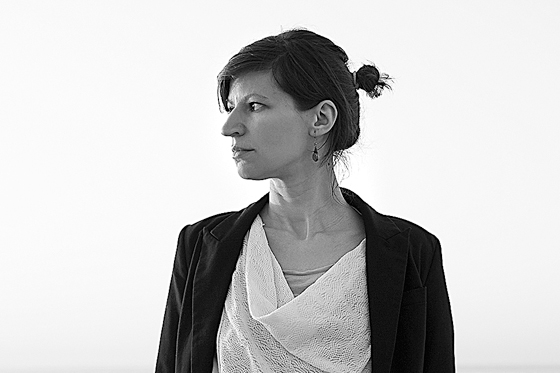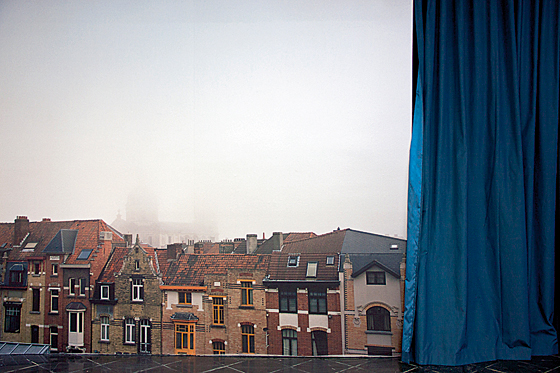|
|
| Where memories of memories live Santa Mičule, Art Academy of Latvia Ieva Epnere. Mindscapes 15.03.–28.04.2013. kim? Contemporary Art Centre | |
| Ieva Epnere’s (born 1977) solo exhibition Mindscapes starts off with the photograph A group of tourists listening to a guide. Nizhny Novgorod (2012). The scene with the guide and the distracted tourists unintentionally foreshadows the feelings that surface during the exhibition. Artist Ilya Kabakov used to compare the accompanying descriptions of contemporary art exhibitions with a theatre programme that one had to consult from time to time in order to be able to follow the dramaturgical development of the play.(1) The explanatory notes of Mindscapes filled in the role of guide, without which a considerable number of works might have remained unseen. It is just as possible that neither the guide nor the map helped the more absentminded visitors, since the route chosen by Epnere was more appropriate for unhurried travellers, not holiday-makers. The title of the exhibition in Latvian Telpas atmiņa, in direct translation – spatial memory, contains a reference to the aspects from which the artist wants viewers to consider the solo exhibition: space and memory are the main “ingredients”, and the show is based on the interaction of the two. Both notions point to the thematic horizons that Ieva Epnere has approached, playing on audiovisual transformations of time and space in various combinations. The impressions of memories have been given tangible form, making public those things that more usually stay behind the unspoken boundaries of privacy. The chance to experience something nonexistent explains why art charged with stories of the past is so alluring – sometimes it allows us to perceive historical nuances to a much finer degree than documentary sources. Epnere’s works exude a similar informa- tional subtlety, revealing the process of how the exhibition was put together. | |
 Ieva Epnere. 2013 Photo: Kristaps Epners Publicity photos Courtesy of the artist | |
| The thematic centre of the solo exhibition is Ieva Epnere’s workshop, representing the last two years of her creative activities which chiefly relate to art studies at HISK (Higher Institute for Fine Arts) in Ghent, Belgium. These influenced her to turn to experimental art, using different media. Stylistically the exhibition could be defined as a creative autobiography – the artist reflected on, remembered and put on display an important creative period of her life. In terms of the media, in this exhibition the artist had distanced herself from photography which had previously dominated her creative output, however, the move away from photography seemed to be only technical: the artist still maintained her typical anthropological view of the world, the merging of the boundaries between the staged and the documentary, as well as an interest in the extraordinary things found in the mundane. Unlike her photo series, in her latest exhibition Epnere not only documented reality – that is unavoidable in pho tography of any genre – but she also reconstructed it like a rebus in the form of spatial objects and moods. The creative process was revealed in two distinct ways. Firstly, as a documentation of concrete places and objects: a picture, video or sound recording; secondly, in the layout of the exhibition, each work connected to and echoing the ideas of the next, thus visualizing the significance of artistic impulse, inspiration and association in Ieva Epnere’s artistic thinking. The strategy of veiled allusion, hints and indications created a desire to liken the script of the exhibition to the putting together of a jigsaw puzzle or solving a crossword, because on taking a closer look it became obvious that the meaning of each individual artwork could be read in some other object. For example, the photo wallpaper was not simply made up of monochromatic fields of colour, but in fact they were closeup fragments of photographs of the artist’s workshop shown alongside. Some of the works were integrated into the exhibition space to the extent that they became almost invisible. This is especially true with regard to the built in window aperture and the audio installation “Тут просвета невидать” 2 (2012) which was played for only a few moments approximately every 10 minutes. Playing hideandseek with the exhibits could at some stage have been a source of irritation, as it interfered with the notion of a comfortable visit where all the works are quickly and easily understood. The sloweddown and meditative rhythm reiterated that the exhibition can be appreciated only by staying in the space for quite some time, just like any living space becomes personal when you have lived there for a while. Mindscapes required an attentive and thorough viewer: the dimension of time is not only applicable to memories, but also to space itself, which reveals itself little by little. Space as a physical entity merged with memories as the subjec- tively emotional part, given that architecture as a personal experi- ence was the guiding motif of the scenography and visual image of the exhibition. Just like other art forms, architecture is also a mental journey in time, able to make time visible for a while. But, in difference to other art forms which we appreciate from a more distanced point of view, not “fusing” with them physically, architecture has the ability to make us part of a different time for a while. Ieva Epenere’s exhibition also attempted to create a similar physical effect of space on the viewer. This was most directly achieved by a video The Vo calist’s Dies Irae or an Extreme Fugue for One Voice (2013), where a human voice was made spatial. According to the artist, the video was an attempt to portray the human body as a spatial structure or place that houses a voice. The unusual vocal performance of singer Laima Lediņa, spanning a range of three octaves, differed substantially from the other works at the exhibition which seemed to seek to remain unnoticed, and was present throughout the entire exhibition visit. Epnere explains that the video work is the end result of the creative processes that were to be seen in the other room of the exhibition. Even though the video was striking and memorable, it did not have an obvious enough link to the other works, and instead seemed to function as a counterweight to the subdued mood of the exhibition. | |
 Ieva Epnere. View from the exhibition Mindscapes. 2013 Photo: Andrejs Strokins Publicity photo Courtesy of the artist | |
| Light is another element that is not fully comprehended but essential, and featured in several works. The way light was used in photographs and videos created aesthetic associations with chrestomathic examples from the history of art photography, where the lighting effects are the leading elements of the mood and composi- tion of a work. Overall, the use of light was in keeping with the church interior elements that had been used: the stained glass panel made in cooperation with Marta Ģibiete (2013), and the builtin window aperture that created associations with religious architecture, just as did the pilaster on which the image of a building façade fragment had been projected and transformed into a reflection of light on the wall (Untitled, 2012 2013). To add to the series of religious motifs, there was also an audio recording made during a visit to a church in Russia, as well the unusual performance by Laima Lediņa which to a viewer in the video room was reminiscent of a religious chant (the work was filmed at the Reformātu church in Riga). An exhibition where sacral elements supplement the theme of the artist’s workshop opens up a wide range of possibilities to interpret it as a metaphorical reference to the sacred character of artistic activity, likening it to a spiritual quest and pointing to the presence of the sacred in the mundane. Possibly religious imagery is a way of generalizing the revelation of specific memories at the exhibition and to make known the artist’s personal ideas about the relationship between art and spirituality. Be that as it may, an unequivocal explanation about the religious aspects of the exhibition was not provided, and its relationship to space and memories was left open to various interpretations. The numerous possibilities of interpretation impeded the per- ception of the artist’s sum total message, because the disparate ac- cents often diverted the attention, making it hard to understand what was important and what was unintentional in the context of the exhibition, and making one doubt if everything was seen and perceived the way it had been intended. The parallels with travel- ling drawn at the beginning of this article were not unintentional, because the searches and discoveries experienced during the exhibition created a feeling of elation similar to the excitement on return- ing from a journey. It must be said that additional references could have helped to identify oneself more completely with the story of the exhibition and to surrender to the artist’s flow of thought. Ieva Epnere’s choice to use the approach of documentary staging in the exhibition seems successful, as she is equally good at both strategies, avoiding falling into the extremes of banal nostalgia or dry photo reportage. The appeal of Mindscapes and the solution to the puzzle is hidden both directly and metaphorically in the details: the quote by Louise Bourgeois: “Happy people have no stories” on the workshop wall and the spider’s web caught among the structure of the wooden pilaster were those elements which most clearly defined how the spatial memory functions. Translator into English: Vita Limanoviča 1 Juliane Rebentisch. Aesthetics of Installation Art. Berlin: Sternberg Press, 2012, p. 166. 2 Translator’s note. Russian: There is no chance of seeing enlightenment here. | |
| go back | |







